Lattice Preferred Orientation and Deformation Microstructures of Glaucophane and Epidote in Experimentally Deformed Epidote Blueschist at High Pressure
Abstract
1. Introduction
2. Methods
2.1. Starting Material
2.2. Deformation Experiment in Simple Shear
2.3. Determination of LPOs of Minerals
2.4. Observation of the Deformation Microstructures in Minerals
3. Results
3.1. Deformation Microstructures after Experiments
3.2. Lattice Preferred Orientations of Glaucophane and Epidote
3.3. Observations of Intracrystalline Deformation Microstructures in Deformed Glaucophane
3.4. Observations of Dislocation Microstructures in Deformed Glaucophane and Epidote Using TEM
4. Discussion
4.1. LPO Formation and Deformation Mechanisms of Glaucophane
4.2. LPO Formation and Deformation Mechanisms of Epidote
4.3. Implications for Deformation Mechanisms of Epidote Blueschist in a Warm Subduction Zone
4.4. Implications for Seismic Anisotropy of Subducting Slab in a Subduction Zone
5. Conclusions
Author Contributions
Funding
Acknowledgments
Conflicts of Interest
References
- Evans, B.W. Phase relations of epidote-blueschists. Lithos 1990, 25, 3–23. [Google Scholar] [CrossRef]
- Peacock, S.M. The importance of blueschist eclogite dehydration reactions in subducting oceanic crust. Geol. Soc. Am. Bull. 1993, 105, 684–694. [Google Scholar] [CrossRef]
- Schmidt, M.W.; Poli, S. Experimentally based water budgets for dehydrating slabs and consequences for arc magma generation. Earth Planet. Sci. Lett. 1998, 163, 361–379. [Google Scholar] [CrossRef]
- Agard, P.; Yamato, P.; Jolivet, L.; Burov, E. Exhumation of oceanic blueschists and eclogites in subduction zones: Timing and mechanisms. Earth-Sci. Rev. 2009, 92, 53–79. [Google Scholar] [CrossRef]
- Ernst, W. Tectonic history of subduction zones inferred from retrograde blueschist PT paths. Geology 1988, 16, 1081–1084. [Google Scholar] [CrossRef]
- Tsujimori, T.; Ernst, W.G. Lawsonite blueschists and lawsonite eclogites as proxies for palaeo-subduction zone processes: A review. J. Metamorph. Geol. 2014, 32, 437–454. [Google Scholar] [CrossRef]
- Hasegawa, A.; Nakajima, J.; Kita, S.; Okada, T.; Matsuzawa, T.; Kirby, S.H. Anomalous deepening of a belt of intraslab earthquakes in the Pacific slab crust under Kanto, central Japan: Possible anomalous thermal shielding, dehydration reactions, and seismicity caused by shallower cold slab material. Geophys. Res. Lett. 2007, 34. [Google Scholar] [CrossRef]
- Kawakatsu, H.; Watada, S. Seismic evidence for deep-water transportation in the mantle. Science 2007, 316, 1468–1471. [Google Scholar] [CrossRef]
- Tsuji, Y.; Nakajima, J.; Hasegawa, A. Tomographic evidence for hydrated oceanic crust of the Pacific slab beneath northeastern Japan: Implications for water transportation in subduction zones. Geophys. Res. Lett. 2008, 35. [Google Scholar] [CrossRef]
- Abers, G.A.; Nakajima, J.; van Keken, P.E.; Kita, S.; Hacker, B.R. Thermal–petrological controls on the location of earthquakes within subducting plates. Earth Planet. Sci. Lett. 2013, 369–370, 178–187. [Google Scholar] [CrossRef]
- Hirose, F.; Nakajima, J.; Hasegawa, A. Three-dimensional seismic velocity structure and configuration of the Philippine Sea slab in southwestern Japan estimated by double-difference tomography. J. Geophys. Res. 2008, 113, 09311–09326. [Google Scholar] [CrossRef]
- Hacker, B.R.; Abers, G.A.; Peacock, S.M. Subduction factory 1. Theoretical mineralogy, densities, seismic wave speeds, and H2O contents. J. Geophys. Res. Solid Earth 2003, 108, 2021–2026, 2029. [Google Scholar] [CrossRef]
- Audet, P.; Kim, Y. Teleseismic constraints on the geological environment of deep episodic slow earthquakes in subduction zone forearcs: A review. Tectonophysics 2016, 670, 1–15. [Google Scholar] [CrossRef]
- Audet, P.; Bostock, M.G.; Boyarko, D.C.; Brudzinski, M.R.; Allen, R.M. Slab morphology in the Cascadia fore arc and its relation to episodic tremor and slip. J. Geophys. Res. 2010, 115. [Google Scholar] [CrossRef]
- Cao, Y.; Jung, H. Seismic properties of subducting oceanic crust: Constraints from natural lawsonite-bearing blueschist and eclogite in Sivrihisar Massif, Turkey. Phys. Earth Planet. Inter. 2016, 250, 12–30. [Google Scholar] [CrossRef]
- Cao, Y.; Jung, H.; Song, S. Petro-fabrics and seismic properties of blueschist and eclogite in the North Qilian suture zone, NW China: Implications for the low-velocity upper layer in subducting slab, trench-parallel seismic anisotropy, and eclogite detectability in the subduction z. J. Geophys. Res. Solid Earth 2013, 118, 3037–3058. [Google Scholar] [CrossRef]
- Kim, D.; Katayama, I.; Michibayashi, K.; Tsujimori, T. Deformation fabrics of natural blueschists and implications for seismic anisotropy in subducting oceanic crust. Phys. Earth Planet. Inter. 2013, 222, 8–21. [Google Scholar] [CrossRef]
- Cao, Y.; Jung, H.; Song, S. Microstructures and petro-fabrics of lawsonite blueschist in the North Qilian suture zone, NW China: Implications for seismic anisotropy of subducting oceanic crust. Tectonophysics 2014, 628, 140–157. [Google Scholar] [CrossRef]
- Ildefonse, B.; Lardeaux, J.-M.; Caron, J.-M. The behavior of shape preferred orientations in metamorphic rocks: Amphiboles and jadeites from the Monte Mucrone area (Sesia-Lanzo zone, Italian Western Alps). J. Struct. Geol. 1990, 12, 1005–1011. [Google Scholar] [CrossRef]
- Zucali, M.; Chateigner, D.; Dugnani, M.; Lutterotti, L.; Ouladdiaf, B. Quantitative texture analysis of glaucophanite deformed under eclogite facies conditions (Sesia-Lanzo Zone, Western Alps): Comparison between X-ray and neutron diffraction analysis. Geol. Soc. Lond. Spec. Publ. 2002, 200, 239–253. [Google Scholar] [CrossRef]
- Reynard, B.; Gillet, P.; Willaime, C. Deformation mechanisms in naturally deformed glaucophanes: A TEM and HREM study. Eur. J. Mineral. 1989, 1, 611–624. [Google Scholar] [CrossRef]
- Wassmann, S.; Stöckhert, B. Rheology of the plate interface—Dissolution precipitation creep in high pressure metamorphic rocks. Tectonophysics 2013, 608, 1–29. [Google Scholar] [CrossRef]
- Brunsmann, A.; Franz, G.; Erzinger, J.; Landwehr, D. Zoisite-and clinozoisite-segregations in metabasites (Tauern Window, Austria) as evidence for high-pressure fluid-rock interaction. J. Metamorph. Geol. 2000, 18, 1–22. [Google Scholar] [CrossRef]
- Müller, W.F.; Franz, G. Unusual deformation microstructures in garnet, titanite and clinozoisite from an eclogite of the Lower Schist Cover, Tauern Window, Austria. Eur. J. Mineral. 2004, 16, 939–944. [Google Scholar] [CrossRef]
- Müller, W.F.; Franz, G. TEM-microstructures in omphacite and other minerals from eclogite near to a thrust zone; the Eclogite Zone–Venediger nappe area, Tauern Window, Austria. Neues Jahrb. Mineral.-Abh. J. Mineral. Geochem. 2008, 184, 285–298. [Google Scholar]
- Franz, G.; Liebscher, A. Physical and Chemical Properties of the Epidote Minerals—An Introduction–. Rev. Mineral. Geochem. 2004, 56, 1–81. [Google Scholar] [CrossRef]
- Stünitz, H.; Tullis, J. Weakening and strain localization produced by syn-deformational reaction of plagioclase. Int. J. Earth Sci. 2001, 90, 136–148. [Google Scholar] [CrossRef]
- Bezacier, L.; Reynard, B.; Bass, J.D.; Wang, J.; Mainprice, D. Elasticity of glaucophane, seismic velocities and anisotropy of the subducted oceanic crust. Tectonophysics 2010, 494, 201–210. [Google Scholar] [CrossRef]
- Ha, Y.; Jung, H.; Raymond, L.A. Deformation fabrics of glaucophane schists and implications for seismic anisotropy: The importance of lattice preferred orientation of phengite. Int. Geol. Rev. 2018, 61, 720–737. [Google Scholar] [CrossRef]
- Fujimoto, Y.; Kono, Y.; Hirajima, T.; Kanagawa, K.; Ishikawa, M.; Arima, M. P-wave velocity and anisotropy of lawsonite and epidote blueschists: Constraints on water transportation along subducting oceanic crust. Phys. Earth Planet. Inter. 2010, 183, 219–228. [Google Scholar] [CrossRef]
- Kim, D.; Katayama, I.; Michibayashi, K.; Tsujimori, T. Rheological contrast between glaucophane and lawsonite in naturally deformed blueschist from Diablo Range, California. Isl. Arc 2013, 22, 63–73. [Google Scholar] [CrossRef]
- Teyssier, C.; Whitney, D.L.; Toraman, E.; Seaton, N.C.A. Lawsonite vorticity and subduction kinematics. Geology 2010, 38, 1123–1126. [Google Scholar] [CrossRef]
- Cossette, É.; Schneider, D.; Audet, P.; Grasemann, B.; Habler, G. Seismic properties and mineral crystallographic preferred orientations from EBSD data: Results from a crustal-scale detachment system, Aegean region. Tectonophysics 2015, 651–652, 66–78. [Google Scholar] [CrossRef]
- Ray, N.J.; Putnis, A.; Gillet, P. Polytypic relationship between clinozoisite and zoisite. Bull. Mineral. 1986, 109, 667–685. [Google Scholar] [CrossRef]
- Cao, Y.; Song, S.; Niu, Y.L.; Jung, H.; Jin, Z.M. Variation of mineral composition, fabric and oxygen fugacity from massive to foliated eclogites during exhumation of subducted ocean crust in the North Qilian suture zone, NW China. J. Metamorph. Geol. 2011, 29, 699–720. [Google Scholar] [CrossRef]
- Malatesta, C.; Crispini, L.; Federico, L.; Capponi, G.; Scambelluri, M. The exhumation of high pressure ophiolites (Voltri Massif, Western Alps): Insights from structural and petrologic data on metagabbro bodies. Tectonophysics 2012, 568–569, 102–123. [Google Scholar] [CrossRef]
- Vignaroli, G.; Rossetti, F.; Bouybaouene, M.; Massonne, H.J.; Theye, T.; Faccenna, C.; Funiciello, R. A counter-clockwise P–T path for the Voltri Massif eclogites (Ligurian Alps, Italy). J. Metamorph. Geol. 2005, 23, 533–555. [Google Scholar] [CrossRef]
- Prior, D.J.; Boyle, A.P.; Brenker, F.; Cheadle, M.C.; Day, A.; Lopez, G.; Peruzzo, L.; Potts, G.J.; Reddy, S.; Spiess, R. The application of electron backscatter diffraction and orientation contrast imaging in the SEM to textural problems in rocks. Am. Mineral. 1999, 84, 1741–1759. [Google Scholar] [CrossRef]
- Lloyd, G.E. Atomic number and crystallographic contrast images with the SEM: A review of backscattered electron techniques. Mineral. Mag. 1987, 51, 3–19. [Google Scholar] [CrossRef]
- Bachmann, F.; Hielscher, R.; Schaeben, H. Grain detection from 2d and 3d EBSD data—Specification of the MTEX algorithm. Ultramicroscopy 2011, 111, 1720–1733. [Google Scholar] [CrossRef]
- Nicolas, A.; Poirier, J.P. Crystalline Plasticity and Solid State Flow in Metamorphic Rocks; John Wiley & Sons: Hoboken, NJ, USA, 1976; p. 444. [Google Scholar]
- van Duysen, J.C.; Doukhan, J.C. Room temperature microplasticity of a spodumene LiAlSi2O6. Phys. Chem. Miner. 1984, 10, 125–132. [Google Scholar] [CrossRef]
- Ko, B.; Jung, H. Crystal preferred orientation of an amphibole experimentally deformed by simple shear. Nat. Commun. 2015, 6, 1–10. [Google Scholar] [CrossRef] [PubMed]
- Jung, H. Crystal preferred orientations of olivine, orthopyroxene, serpentine, chlorite, and amphibole, and implications for seismic anisotropy in subduction zones: A review. Geosci. J. 2017, 21, 985–1011. [Google Scholar] [CrossRef]
- Drury, M.R.; Urai, J.L. Deformation-related recrystallization processes. Tectonophysics 1990, 172, 235–253. [Google Scholar] [CrossRef]
- Deer, W.A.; Howie, R.A.; Zussman, J. Rock-Forming Minerals: Disilicates and Ring Silicates, 2nd ed.; Geological Society of London: London, UK, 1986; p. 629. [Google Scholar]
- Kohlstedt, D.; Evans, B.; Mackwell, S. Strength of the lithosphere: Constraints imposed by laboratory experiments. J. Geophys. Res. Solid Earth 1995, 100, 17587–17602. [Google Scholar] [CrossRef]
- Karato, S.-I. Deformation of Earth Materials: An Introduction to the Rheology of Solid Earth; Cambridge University Press: Cambridge, UK, 2008; p. 463. [Google Scholar]
- Kim, D.; Katayama, I.; Wallis, S.; Michibayashi, K.; Miyake, A.; Seto, Y.; Azuma, S. Deformation microstructures of glaucophane and lawsonite in experimentally deformed blueschists: Implications for intermediate-depth intraplate earthquakes. J. Geophys. Res. Solid Earth 2015, 120, 1229–1242. [Google Scholar] [CrossRef]
- Balestro, G.; Festa, A.; Tartarotti, P. Tectonic significance of different block-in-matrix structures in exhumed convergent plate margins: Examples from oceanic and continental HP rocks in Inner Western Alps (Northwest Italy). Int. Geol. Rev. 2014, 57, 581–605. [Google Scholar] [CrossRef]
- Ukar, E.; Cloos, M. Cataclastic deformation and metasomatism in the subduction zone of mafic blocks-in-mélange, San Simeon, California. Lithos 2019, 346–347, 105116. [Google Scholar] [CrossRef]
- Ebert, A.; Herwegh, M.; Pfiffner, A. Cooling induced strain localization in carbonate mylonites within a large-scale shear zone (Glarus thrust, Switzerland). J. Struct. Geol. 2007, 29, 1164–1184. [Google Scholar] [CrossRef]
- Long, M.D. Constraints on Subduction Geodynamics from Seismic Anisotropy. Rev. Geophys. 2013, 51, 76–112. [Google Scholar] [CrossRef]
- Long, M.D.; Becker, T.W. Mantle dynamics and seismic anisotropy. Earth Planet. Sci. Lett. 2010, 297, 341–354. [Google Scholar] [CrossRef]
- Jung, H.; Karato, S.-I. Water-induced fabric transitions in olivine. Science 2001, 293, 1460–1463. [Google Scholar] [CrossRef] [PubMed]
- Karato, S.-I.; Jung, H.; Katayama, I.; Skemer, P. Geodynamic significance of seismic anisotropy of the upper mantle: New insights from laboratory studies. Annu. Rev. Earth Planet. Sci. 2008, 36, 59–95. [Google Scholar] [CrossRef]
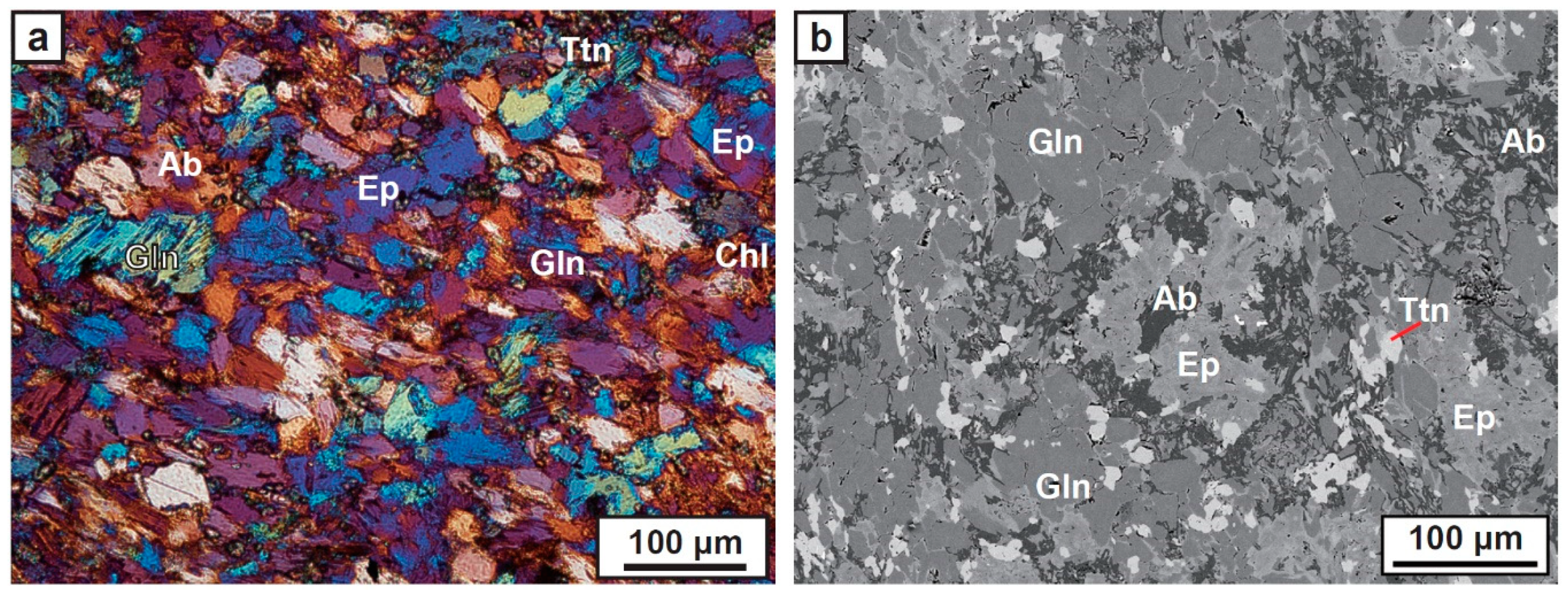
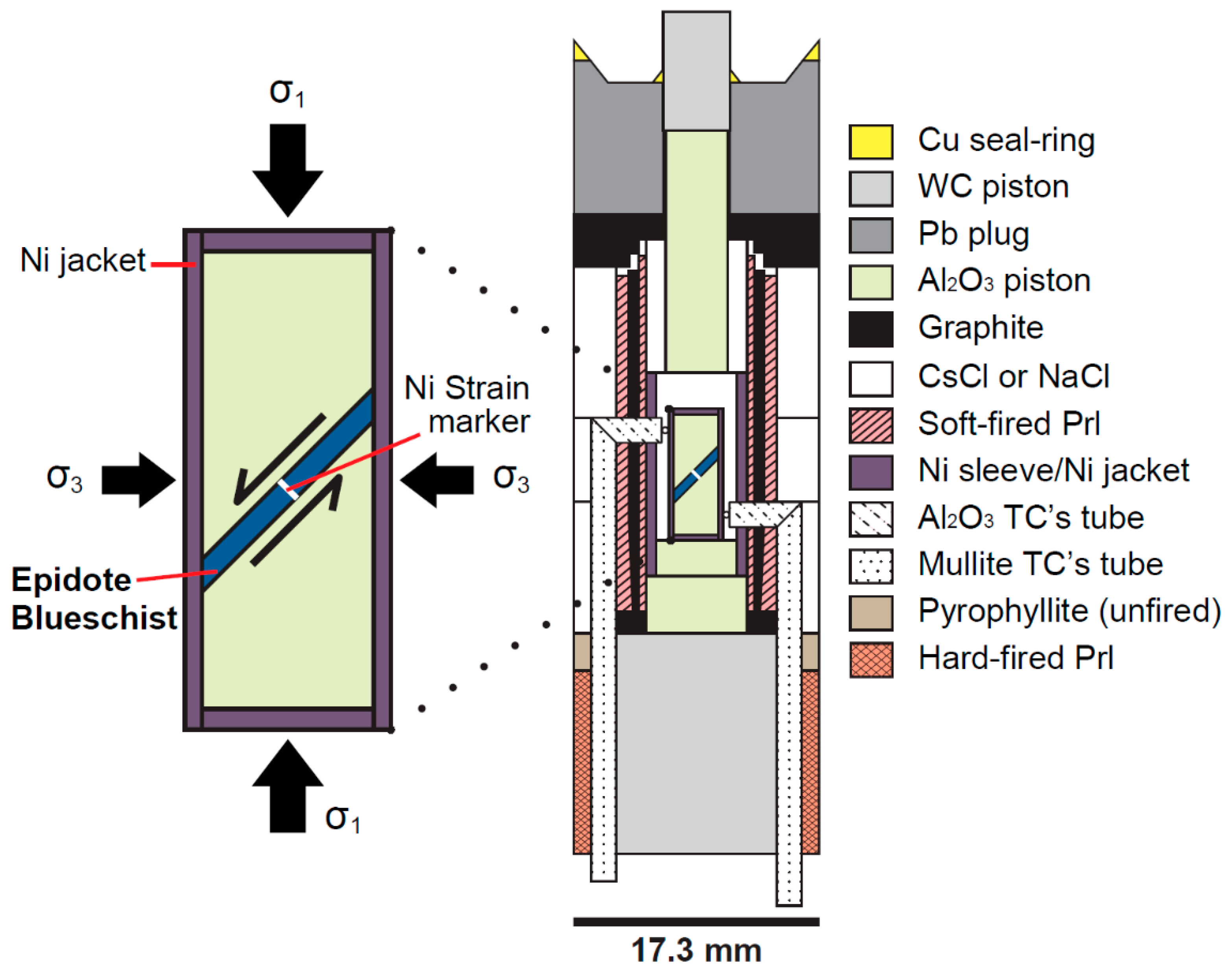
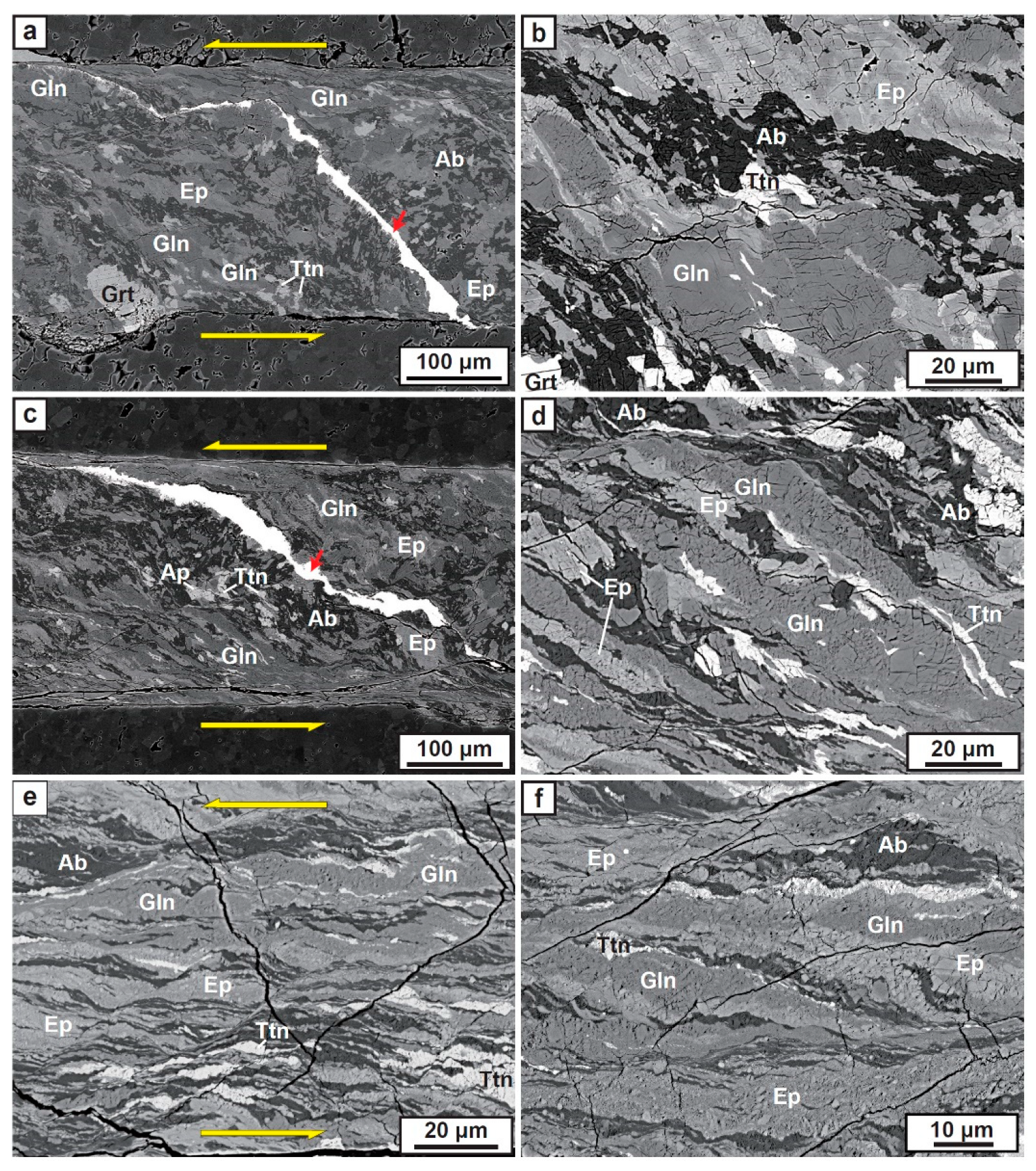
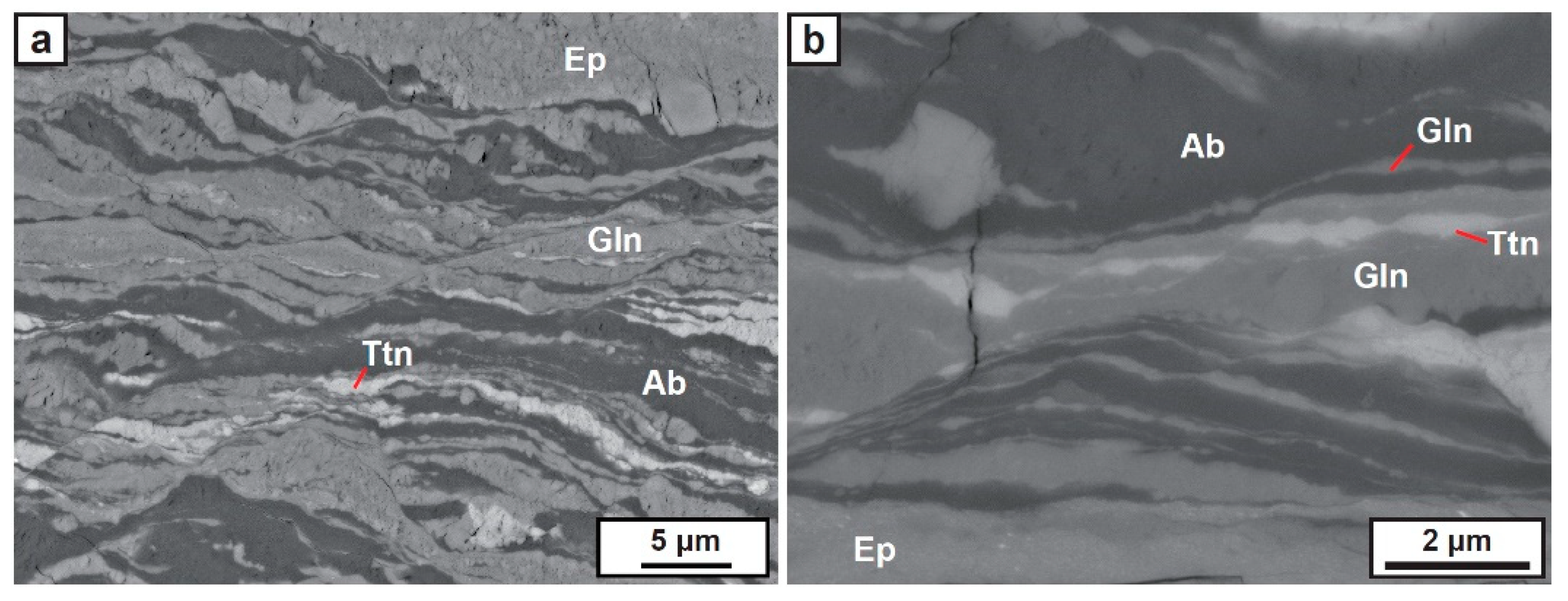

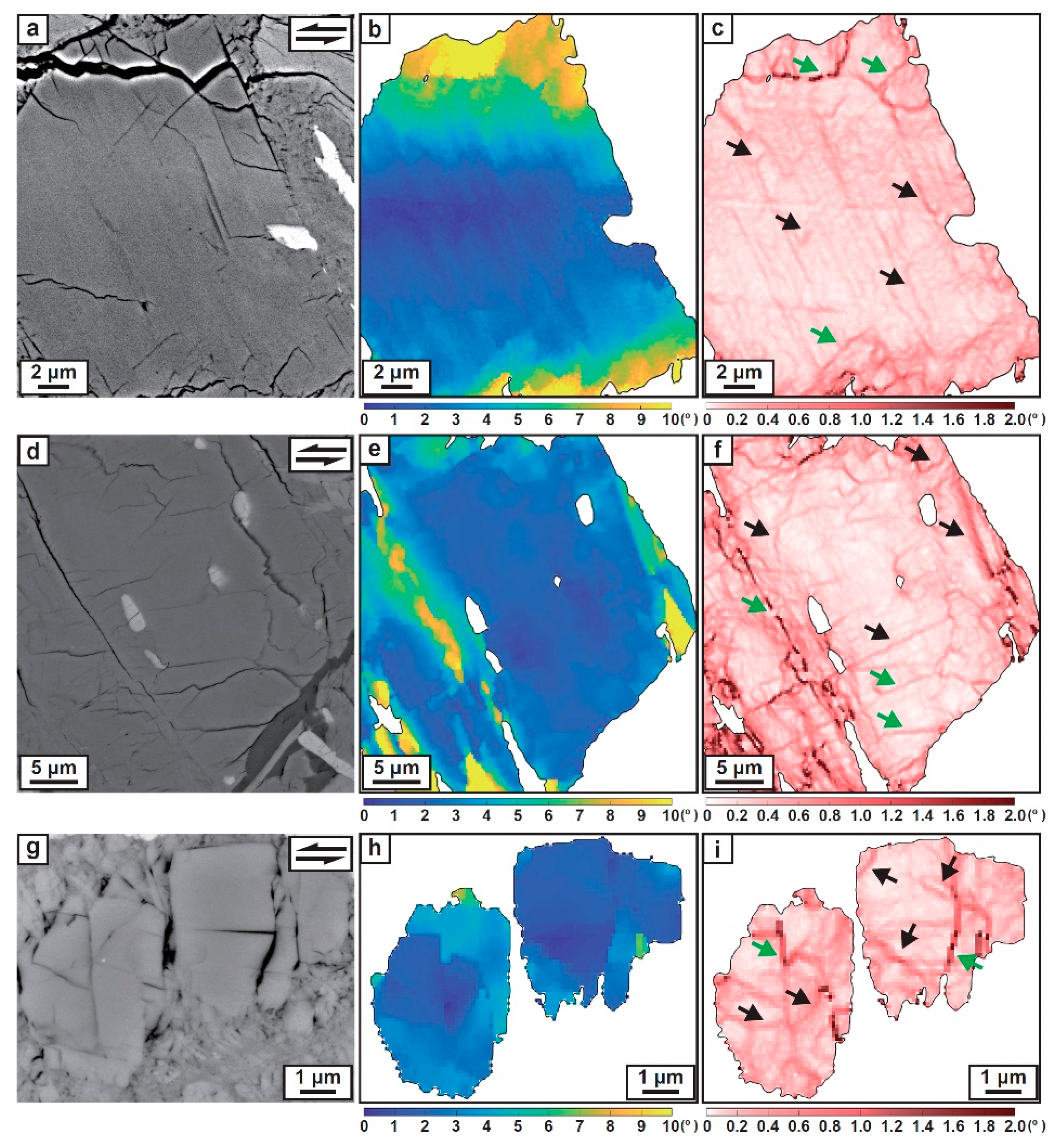

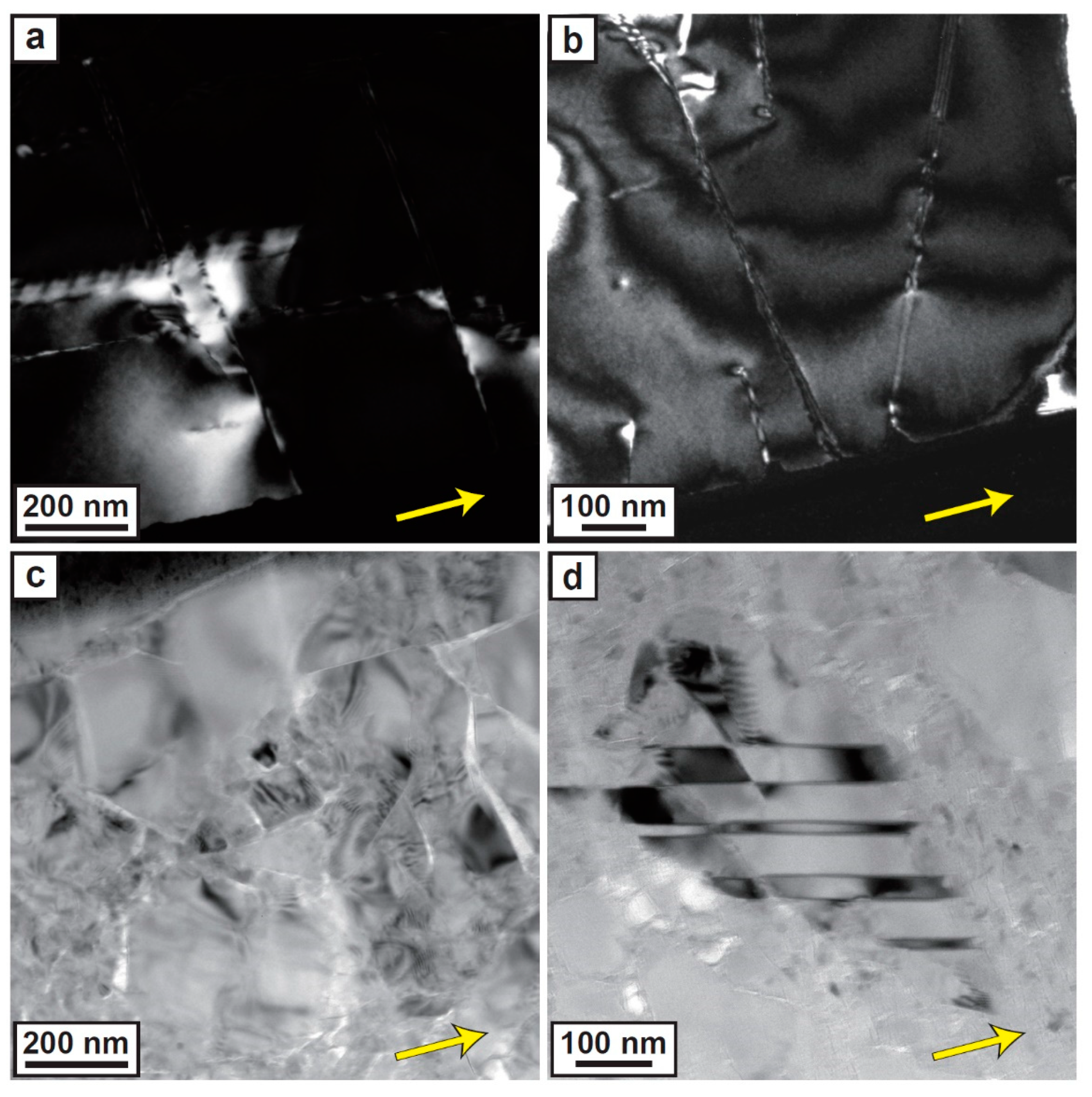
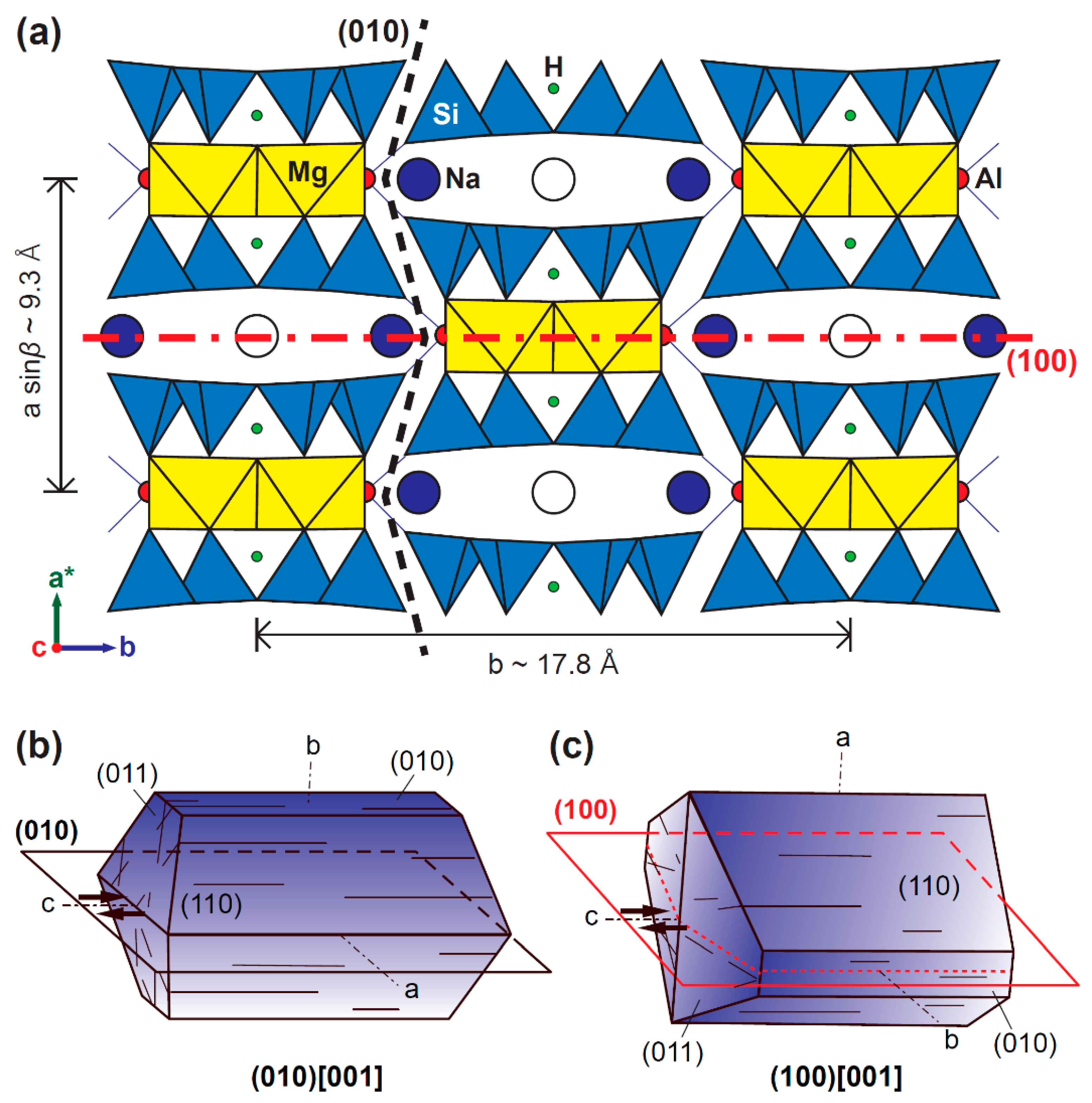
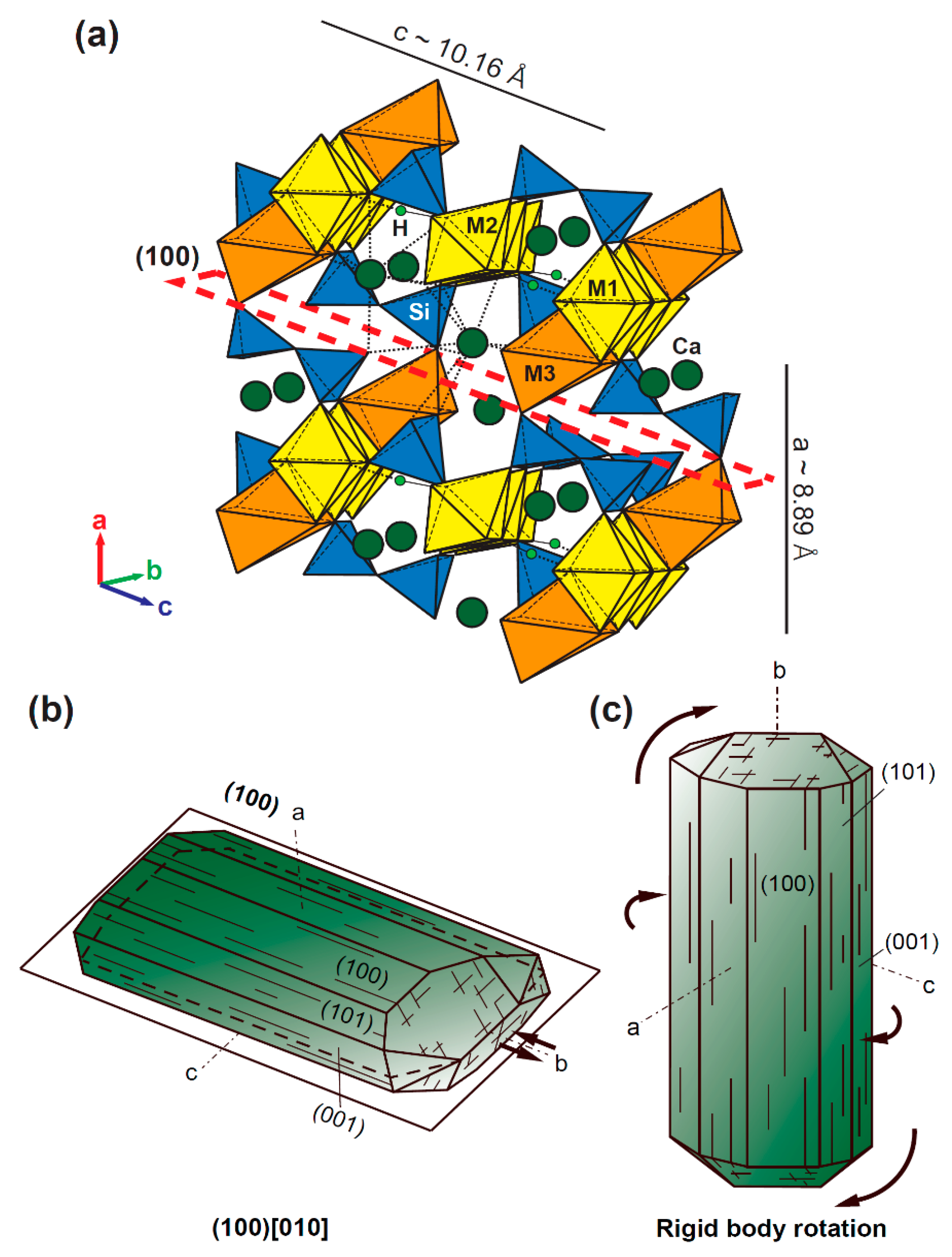
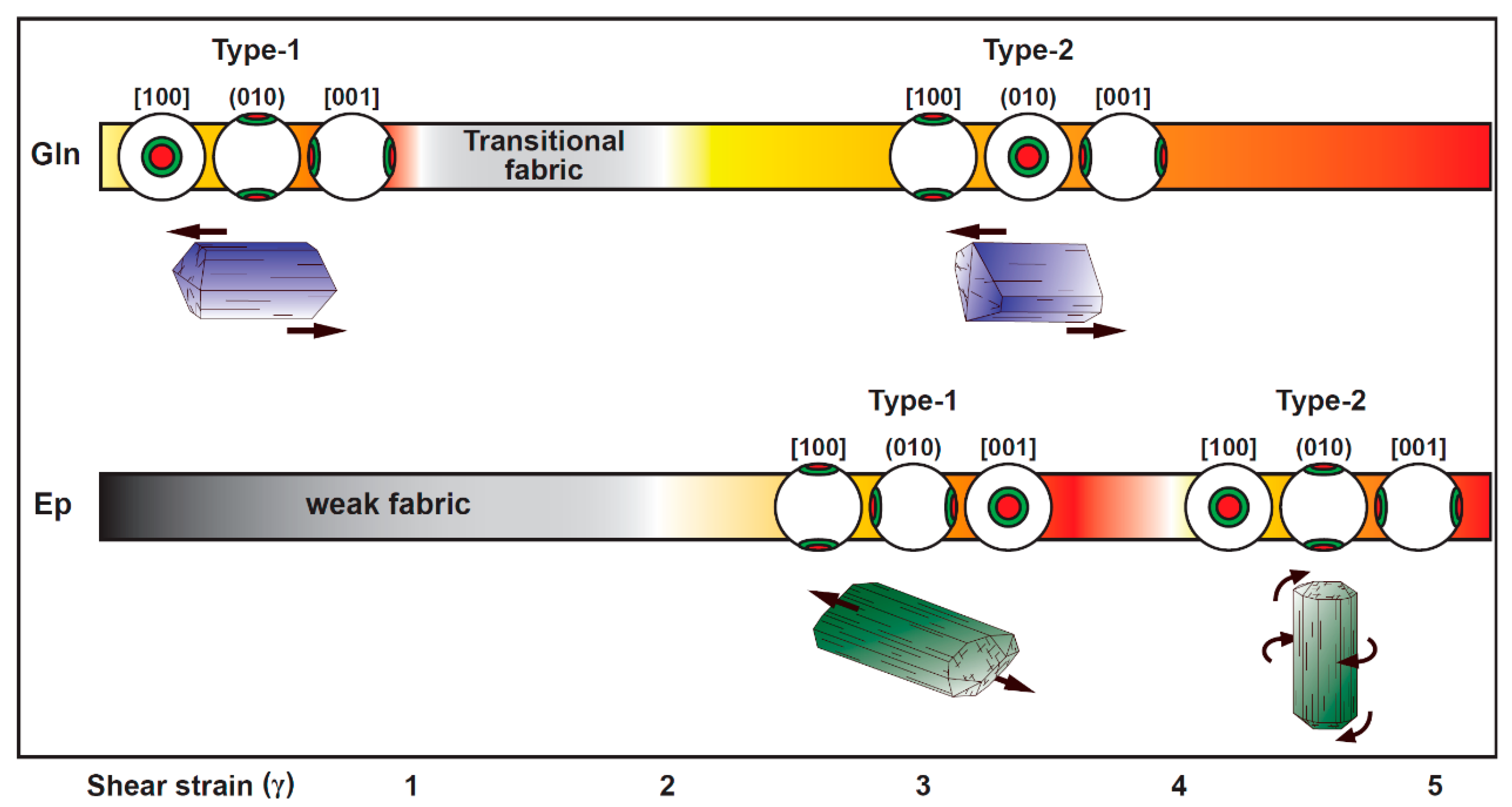
| Element | SiO2 | TiO2 | Al2O3 | Cr2O3 | FeO | MgO | CaO | MnO | Na2O | K2O | NiO | Total |
|---|---|---|---|---|---|---|---|---|---|---|---|---|
| Gln | 57.31 | 0.03 | 10.68 | 0.03 | 11.92 | 8.22 | 0.26 | 0.08 | 7.30 | n.d. | n.d. | 95.84 |
| Ep | 38.02 | 0.00 | 26.76 | n.d. | 7.61 | 0.03 | 23.37 | 0.07 | 0.03 | 0.01 | n.d. | 95.90 |
| Cation | Si | Ti | Al | Cr | Fe2+ | Fe3+ | Mg | Ca | Mn | Na | K | Sum |
| Gln | 8.06 | 0.00 | 1.77 | 0.00 | 1.31 | 0.09 | 1.73 | 0.04 | 0.01 | 1.99 | - | 15.01 |
| Ep | 3.01 | 0.00 | 2.49 | - | 0.00 | 0.50 | 0.00 | 1.98 | 0.00 | 0.00 | 0.00 | 7.99 |
| Gln | Si [T] | Ti [T] | Al [T] | Ti [C] | Al [C] | Cr [C] | Fe2+ [C] | Fe3+ [C] | Mg [C] | Ca [C] | Mn [C] | - |
| Cal. # | 8.06 | 0.00 | 0.00 | 0.00 | 1.77 | 0.00 | 1.31 | 0.09 | 1.72 | 0.04 | 0.01 | - |
| Gln | Fe2+ [B] | Mg [B] | Ca [B] | Mn [B] | Na [B] | Na [A] | Ca [A] | K [A] | - | - | - | - |
| Cal. # | 0.00 | 0.00 | 0.00 | 0.00 | 1.99 | 0.00 | 0.00 | 0.00 | - | - | - | - |
| Ep | Si [T] | AlIV [T] | Ti [M] | Cr [M] | AlVI [M] | Fe3+ [M] | Mg [M] | Mn [M] | Na [M] | K [M] | Ca [A] | - |
| Cal. # | 3.01 | 0.00 | 0.00 | 0.00 | 2.49 | 0.50 | 0.00 | 0.00 | 0.00 | 0.00 | 1.98 | - |
| Run # | P (GPa) | T (°C) | Peak σd (MPa) | Shear Strain (γ) | Shear Strain Rate (s−1) | LPO of Gln | LPO of Ep |
|---|---|---|---|---|---|---|---|
| JH148 | 1.2 | 430 ± 10 | 700 ± 20 | 0.4 ± 0.02 | 1.5 × 10−5 | Type-1 | Weak fabric |
| JH98b | 1.5 | 500 ± 10 | 710 ± 20 | 0.6 ± 0.03 | 3.4 × 10−5 | Type-1 | Weak fabric |
| JH88b | 1.5 | 400 ± 10 | 800 ± 20 | 0.8 ± 0.03 | 4.4 × 10−5 | Type-1 | Weak fabric |
| JH112b | 0.9 | 430 ± 10 | 720 ± 20 | 0.9 ± 0.03 | 4.2 × 10−5 | Type-1 | Weak fabric |
| JH94b | 1.5 | 400 ± 10 | 900 ± 20 | 1.5 ± 0.06 | 6.0 × 10−5 | Transitional | Weak fabric |
| JH88a | 1.5 | 400 ± 10 | 800 ± 20 | 2.1 ± 0.12 | 1.2 × 10−4 | Type-2 | Type-1 |
| JH98a | 1.5 | 500 ± 10 | 710 ± 20 | 2.4 ± 0.12 | 1.4 × 10−4 | Type-2 | Type-1 |
| JH150 | 1.2 | 480 ± 10 | 680 ± 20 | 2.7 ± 0.15 | 1.2 × 10−4 | Type-2 | Type-1 |
| JH112a | 0.9 | 430 ± 10 | 720 ± 20 | 2.9 ± 0.20 | 1.4 × 10−4 | Type-2 | Type-1 |
| JH94a | 1.5 | 400 ± 10 | 900 ± 20 | 4.5 ± 0.38 | 1.8 × 10−4 | Type-2 | Type-2 |
© 2020 by the authors. Licensee MDPI, Basel, Switzerland. This article is an open access article distributed under the terms and conditions of the Creative Commons Attribution (CC BY) license (http://creativecommons.org/licenses/by/4.0/).
Share and Cite
Park, Y.; Jung, S.; Jung, H. Lattice Preferred Orientation and Deformation Microstructures of Glaucophane and Epidote in Experimentally Deformed Epidote Blueschist at High Pressure. Minerals 2020, 10, 803. https://doi.org/10.3390/min10090803
Park Y, Jung S, Jung H. Lattice Preferred Orientation and Deformation Microstructures of Glaucophane and Epidote in Experimentally Deformed Epidote Blueschist at High Pressure. Minerals. 2020; 10(9):803. https://doi.org/10.3390/min10090803
Chicago/Turabian StylePark, Yong, Sejin Jung, and Haemyeong Jung. 2020. "Lattice Preferred Orientation and Deformation Microstructures of Glaucophane and Epidote in Experimentally Deformed Epidote Blueschist at High Pressure" Minerals 10, no. 9: 803. https://doi.org/10.3390/min10090803
APA StylePark, Y., Jung, S., & Jung, H. (2020). Lattice Preferred Orientation and Deformation Microstructures of Glaucophane and Epidote in Experimentally Deformed Epidote Blueschist at High Pressure. Minerals, 10(9), 803. https://doi.org/10.3390/min10090803






